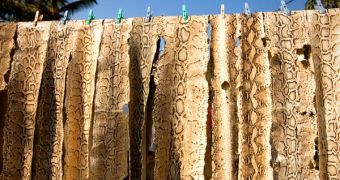A new study made public on Tuesday, November 27 in Geneva, Switzerland shows that over half a million python skins, worth $1 billion (€0.77 billion) are being annually exported from South-East Asia.
The study named The Trade in South-East Asian Python Skins was conducted by the International Trade Center (ITC) along with TRAFFIC and the International Union for the Conservation of Nature (IUCN).
The results of the study show worrying facts related to the legality of the trading, as well as to the wellbeing and conservation of pythons, TRAFFIC reports.
“It would appear a substantial proportion of the skins in trade are sourced illegally from wild animals, beyond agreed quotas, and using false permits to launder the skins,” said Tomas Waller, head of the IUCN's Boa and Python Specialist Group (BPSG).
Most of the skin production is being delivered to the European fashion industry, with Malaysia, Vietnam and Indonesia being the main exporters, and Germany, Italy and France – the biggest clients.
“The report shows that problems of illegality persist in the trade in python skins and that this can threaten species’ survival,” declared Alexander Kasterine, leader of the Trade and Environment Programme at ITC.
“The fashion and leather industry has a stronger role to play in supporting Convention on International Trade in Endangered Species of Wild Flora and Fauna (CITES) and developing countries to ensure supply is legal and sustainable.”
Authors of the study suggest that the fashion industry representatives developed a system which would allow the skins' tracking along the trading route and the demonstration of their legality.
“With potentially large mark-ups along the supply chain, there is a strong financial incentive for illegal trade in python skins and considerable scope for traders to issue false permits,” explained Olivier Caillabet, co-author of the study and Programme Officer at TRAFFIC in South-East Asia.

 14 DAY TRIAL //
14 DAY TRIAL //